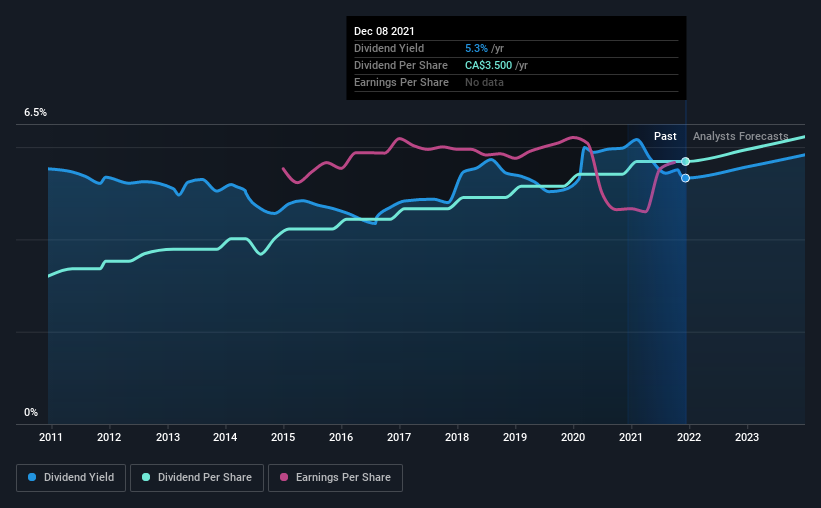Here's Why We're Wary Of Buying BCE's (TSE:BCE) For Its Upcoming Dividend
BCE Inc. (TSE:BCE) is about to trade ex-dividend in the next 4 days. The ex-dividend date is one business day before the record date, which is the cut-off date for shareholders to be present on the company's books to be eligible for a dividend payment. The ex-dividend date is important because any transaction on a stock needs to have been settled before the record date in order to be eligible for a dividend. In other words, investors can purchase BCE's shares before the 14th of December in order to be eligible for the dividend, which will be paid on the 15th of January.
The company's next dividend payment will be CA$0.88 per share, and in the last 12 months, the company paid a total of CA$3.50 per share. Based on the last year's worth of payments, BCE has a trailing yield of 5.3% on the current stock price of CA$65.69. Dividends are a major contributor to investment returns for long term holders, but only if the dividend continues to be paid. So we need to investigate whether BCE can afford its dividend, and if the dividend could grow.
Check out our latest analysis for BCE
Dividends are typically paid out of company income, so if a company pays out more than it earned, its dividend is usually at a higher risk of being cut. BCE distributed an unsustainably high 113% of its profit as dividends to shareholders last year. Without extenuating circumstances, we'd consider the dividend at risk of a cut. That said, even highly profitable companies sometimes might not generate enough cash to pay the dividend, which is why we should always check if the dividend is covered by cash flow. BCE paid out more free cash flow than it generated - 123%, to be precise - last year, which we think is concerningly high. We're curious about why the company paid out more cash than it generated last year, since this can be one of the early signs that a dividend may be unsustainable.
Cash is slightly more important than profit from a dividend perspective, but given BCE's payments were not well covered by either earnings or cash flow, we are concerned about the sustainability of this dividend.
Click here to see the company's payout ratio, plus analyst estimates of its future dividends.
Have Earnings And Dividends Been Growing?
Companies that aren't growing their earnings can still be valuable, but it is even more important to assess the sustainability of the dividend if it looks like the company will struggle to grow. Investors love dividends, so if earnings fall and the dividend is reduced, expect a stock to be sold off heavily at the same time. That explains why we're not overly excited about BCE's flat earnings over the past five years. We'd take that over an earnings decline any day, but in the long run, the best dividend stocks all grow their earnings per share. With limited earnings growth and paying out a concerningly high percentage of its earnings, the prospects of future dividend growth don't look so bright here.
The main way most investors will assess a company's dividend prospects is by checking the historical rate of dividend growth. Since the start of our data, 10 years ago, BCE has lifted its dividend by approximately 5.9% a year on average.
The Bottom Line
Is BCE an attractive dividend stock, or better left on the shelf? Earnings per share are effectively flat, plus BCE's dividend is not well covered by either earnings or cash flow, which is not great. Overall it doesn't look like the most suitable dividend stock for a long-term buy and hold investor.
With that in mind though, if the poor dividend characteristics of BCE don't faze you, it's worth being mindful of the risks involved with this business. To that end, you should learn about the 2 warning signs we've spotted with BCE (including 1 which is concerning).
We wouldn't recommend just buying the first dividend stock you see, though. Here's a list of interesting dividend stocks with a greater than 2% yield and an upcoming dividend.
Have feedback on this article? Concerned about the content? Get in touch with us directly. Alternatively, email editorial-team (at) simplywallst.com.
This article by Simply Wall St is general in nature. We provide commentary based on historical data and analyst forecasts only using an unbiased methodology and our articles are not intended to be financial advice. It does not constitute a recommendation to buy or sell any stock, and does not take account of your objectives, or your financial situation. We aim to bring you long-term focused analysis driven by fundamental data. Note that our analysis may not factor in the latest price-sensitive company announcements or qualitative material. Simply Wall St has no position in any stocks mentioned.

 Yahoo Finance
Yahoo Finance 
